 CLOUD
CLOUD
 CLOUD
CLOUD
 CLOUD
CLOUD
Oracle Corp. is seeing renewed business momentum powered by a combination of an entrenched database business, years of investment in cloud infrastructure, an integrated application suite and artificial intelligence technologies that are being infused throughout its product line.
This includes its autonomous database, 23ai, Exadata/Exascale, other Oracle infrastructure and its vast applications portfolio. Oracle has a highly differentiated strategy that is hitting on most if not all cylinders. And it appears the best is yet to come. It’s one reason that, year to date, the stock is up 54%, compared with the Nasdaq, which is up 19% as of the recording of this recording.
In this Breaking Analysis, we share our analysis of Oracle CloudWorld, held this week in Las Vegas. We’ll explore highlights from the event, examine the firm’s differentiated stack and look at some survey data from Enterprise Technology Research that supports our thesis.
First let’s take a snapshot of Oracle’s earnings from its most recent fiscal first quarter.
Below is a screenshot of the company’s income statement from last quarter with our rough estimates of what the full fiscal year will look like. Chief Executive Safra Catz was very proud of the fact that Oracle’s first fiscal quarter ended on Aug. 31 and it released earnings, with guidance, on Tuesday, Sept. 10. That’s five business days after the quarter ended, which is quite remarkable and best in class.
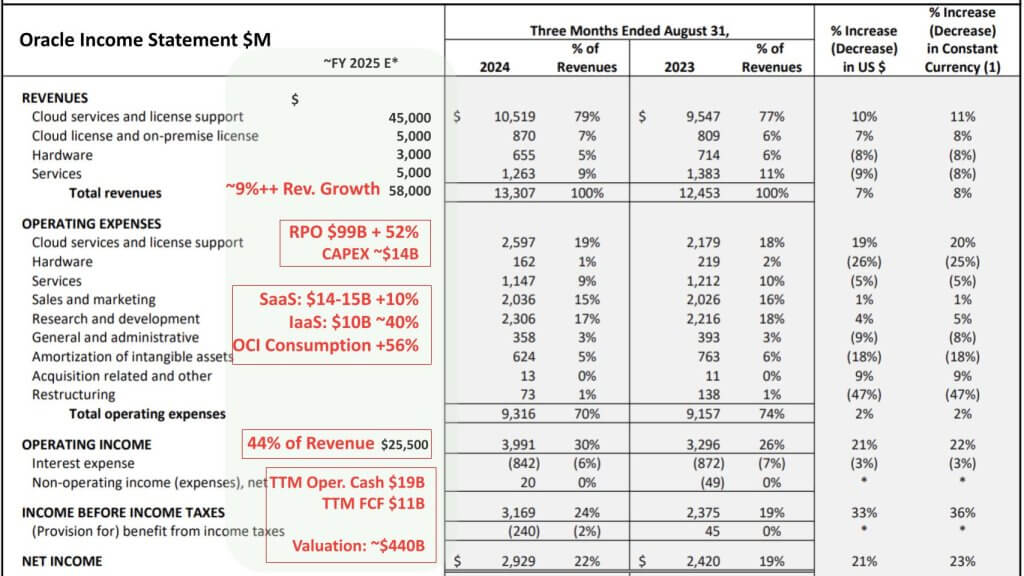
Note: At its financial analyst meeting from CloudWorld, Oracle increased its FY 26 revenue growth rate to the mid teens, generating $66 billion. As well, it increased its FY 2029 revenue goal to $104 billion, which would give it a valuation by today’s metrics closing in on $1 trillion.
We won’t go through all this data in detail, but we do want to highlight a few points. Oracle’s top-line revenue came in at just over $13 billion for the quarter at an 8% growth rate relative to last year’s Q1. We estimate that their business is accelerating and it will end up doing $58 billion in revenue this fiscal year, growing 9% overall relative to FY 2024. And the reason is shown in red, with remaining performance obligations of $99 billion, up 52%. This combined with a capital spend of $14 billion, primarily for data center buildouts, is what is giving investors such enthusiasm for the future.
Moving into some of the critical line items of the business: We see Oracle’s cloud SaaS business coming in at between $14 billion and $15 billion this year and an infrastructure-as-a-service business at $10 billion, growing in the ~40% range. Last quarter, its Oracle Cloud Infrastructure consumption revenue increased 56%, down from the mid 60s last quarter with continued expected high rates throughout the year.
For context, an IaaS business of $10 billion puts Oracle just behind Alibaba and at about 10% the size of Amazon Web Services Inc.’s IaaS business. But if you include SaaS + IaaS, it’s a business that’s about $25 billion, compared with Google’s combined IaaS and SaaS at about $40 billion this year. So in that sense it’s getting pretty sizable — s.till a distance from the big hyperscalers but closing in with a faster growth rate.
What’s frankly more interesting is not the comparison with other clouds, but rather the profitability of its business. We expect Oracle will finish its FY with around a 44% operating margin. This is Microsoft-level operating margin. Its trailing-12-month cash flow is at $19 billion on an operating basis with $11 billion in free cash flow.
All this leads to a valuation more than $440 billion as of this episode’s recording. Oracle has built an incredible business. We have little doubt that co-founder and Chief Technology Officer Larry Ellison aspires to get to a $1 trillion valuation and is investing to do so.
There were more than 20,000, perhaps 25,000 attendees this year. The big news was the AWS partnership, which we’re depicting below. Oracle had AWS CEO Matt Garman on stage with a joint customer, the chief technology officer of State Street.
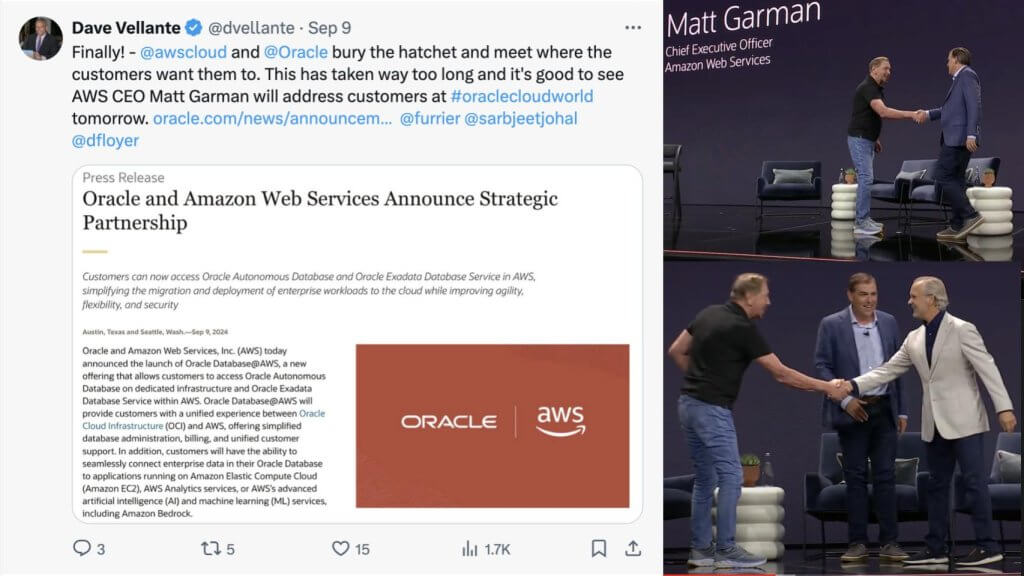
After this love in with Matt Garman, Larry declared the start of the multicloud era. This is classic Larry. He loves to take a trend that has been around for a while, reimagine it, then put forth a highly differentiated strategy and declare that the thing is now real — that is, he created it. But his multicloud strategy is unique, and in our view, one of the strongest, if not the strongest, in the infrastructure cloud business.
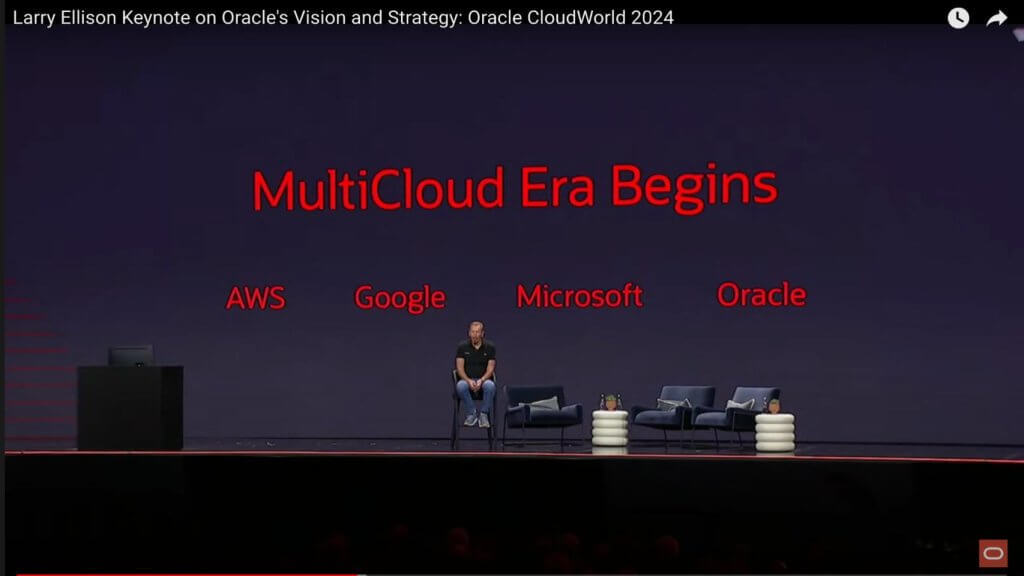
Beyond multicloud, Larry focused on security. His message resonated. He said the following:
Let me tell you, we’re done with passwords. The idea is utterly ridiculous. They’re easily hacked. The more difficult they are to remember, the more likely you are to write them down, the more likely they are to be stolen. Everything done to make passwords better has made them worse. It’s a terrible idea. So we’re getting rid of passwords entirely. This is the way you’re going to log on to work. I’m going to type in larry.ellison@oracle.com. The computer’s going to look at me and say, ‘Okay, hi Larry. We’re done.’ Why would I type? Safra can recognize me, my kids can recognize me. You’re telling me a computer can’t recognize me and log in? This is ridiculous.
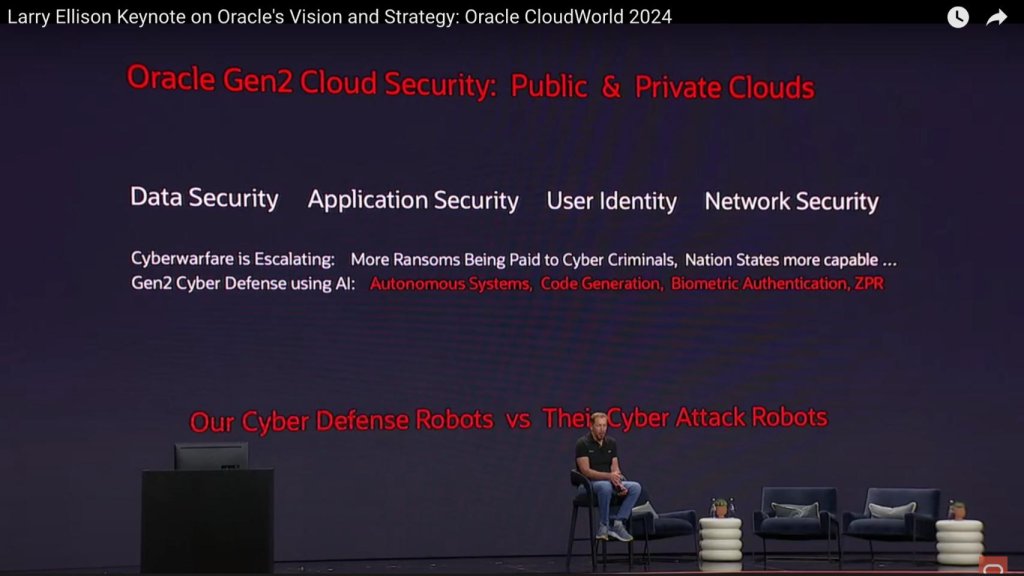
Not only was this hilarious… it rings true.
Ellison discussed his point of view around four pillars of security: data, application, user identity and network. He stressed that you can’t have great security without full automation.
The following additional points summarize our views of Oracle CloudWorld. We believe the event was a critical moment in emphasizing the evolving narrative around multicloud. Though multicloud as a concept has been discussed for years, in our view, Oracle’s particular strategy diverges by leveraging its unique legacy as a systems vendor, most notably with the acquisition of Sun Microsystems and its pivot to engineered systems. The company’s focus on infrastructure, underscored by solutions like Exadata and Exascale, positions Oracle as a key player in the next-generation hyperscaler ecosystem.
In our opinion, the company has effectively addressed longstanding customer concerns by presenting a clear message that reflects an engineering-driven culture. Importantly, unlike many past events, Oracle avoided the pitfalls of overhyping capabilities, particularly as it highlighted its partnerships with AWS, Google LLC and Microsoft Corp. Rather than taking an aggressive posture as a competitor, the tone of the conference underscored its growing collaboration with hyperscalers.
Key takeaways include:
In our view, Oracle’s commitment to completely homogenous infrastructure (same: same), whether on-premises or in the cloud, puts the company in a novel position relative to infrastructure firms without a cloud. Relative to the hyperscalers, Oracle’s on-premises legacy confers additional advantage giving customers maximum flexibility.
In our view, Oracle’s “opinionated stack” offers a distinct competitive edge, particularly in the multicloud era. Its portfolio, which spans from infrastructure with Oracle Cloud Infrastructure or OCI to mission-critical applications, presents an integrated approach that is uncommon in the industry. Oracle’s ability to tightly integrate its Fusion Applications with both first- and third-party services positions them as a leader in this space. Notably, Fusion Data Intelligence and the acquisition of Cerner, infused with AI, underscore Oracle’s commitment to embedding intelligence into its portfolio.
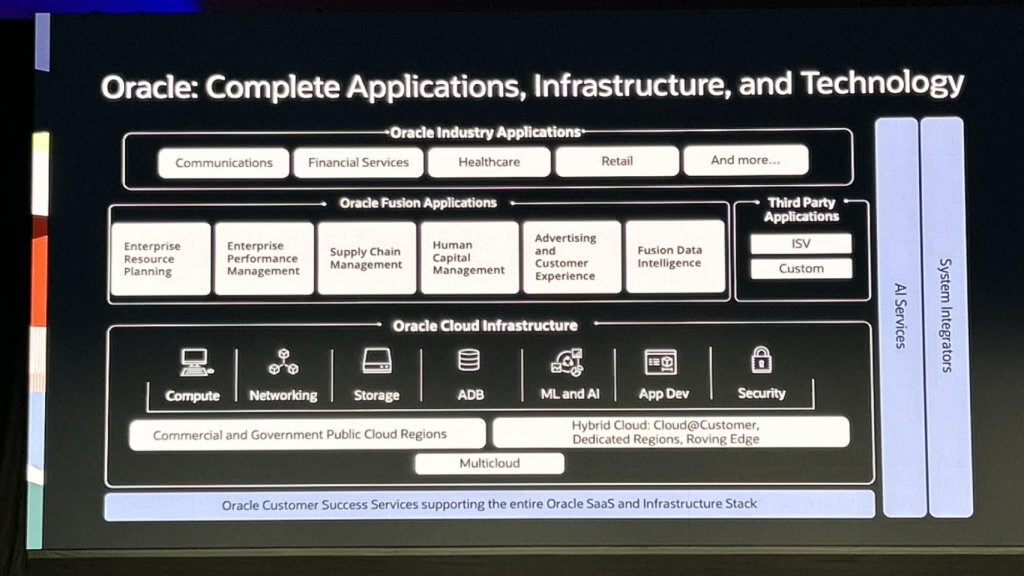
Specifically, Oracle’s vertical integration of AI from infrastructure through the application layer is particularly compelling. Oracle claims its integration is designed to be agnostic from the customer’s perspective. For example, whether Oracle swaps out one AI foundation model for another does not impact the end user experience according to the company and it remains focused on providing accurate, secure and private infrastructure.
Key differentiators include:
In our assessment, Oracle’s emphasis on vertical integration and its focus on mission-critical enterprise applications differentiate it from the likes of Microsoft, AWS, SAP SE and IBM Corp. While competitors may have strengths in certain areas, Oracle’s holistic approach, supported by a robust ecosystem of GSIs such as Accenture and Deloitte, puts it in a unique position to drive value in enterprise information technology environments.
Everyone is trying to get AI right. There are a lot of questions right now about embedded AI or bespoke and “When are we going to see the payback? What’s the ROI and when are we going to get a return on all this CapEx investment?” Ellison summed it up on the earnings call this week as shown below.
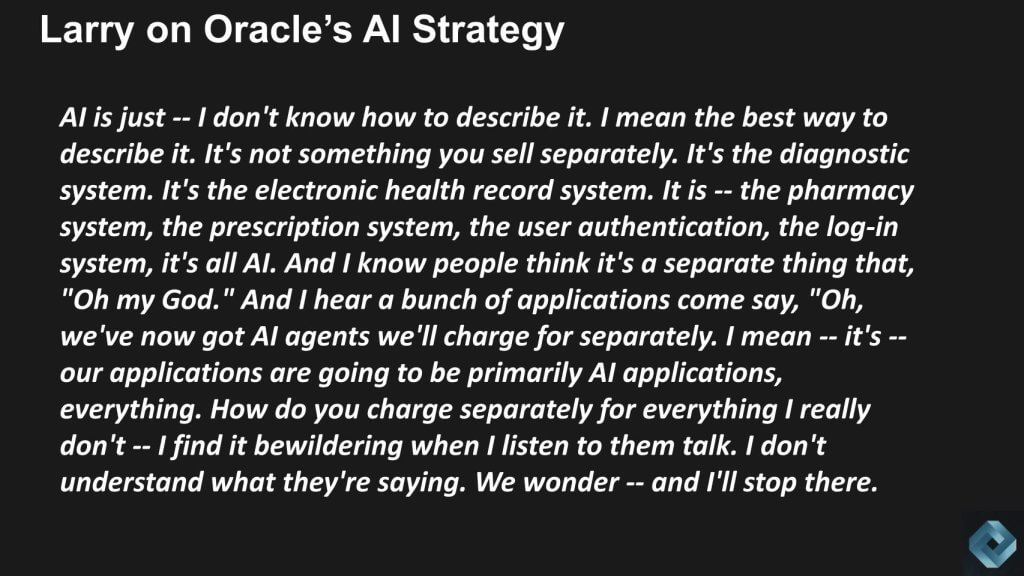
We believe Oracle’s approach to integrating AI within its applications is the sensible path for firms with a large portfolio. Unlike competitors such as Google and Microsoft/OpenAI, which are heavily invested in developing large language models and need to recoup their significant investments, Oracle has chosen a different path. Oracle’s current posture to not focus on building LLMs, underscores its pragmatic approach to AI. Instead of engaging in an arms race over AI development, Oracle is more focused on embedding AI where it adds direct value for customers.
This approach sets Oracle apart in several key ways:
In our view, Oracle’s embedded approach to AI development reflects a strategy that prioritizes immediate, tangible benefits for its customers. This differentiates Oracle from some competitors, which are focused on recouping large investments in AI research.
Clay Magouyrk, Oracle’s executive vice president of OCI, provided a deep dive into OCI at both the keynote and in private analyst sessions. Our thoughts follow.
Oracle’s aggressive expansion of OCI illustrates its commitment to establishing a robust global presence in the cloud market. Clay in his keynote said that Oracle has 59 regions planned and live, while Larry on the earnings call said Oracle now has 85 cloud regions live and an additional 77 planned with more to follow.
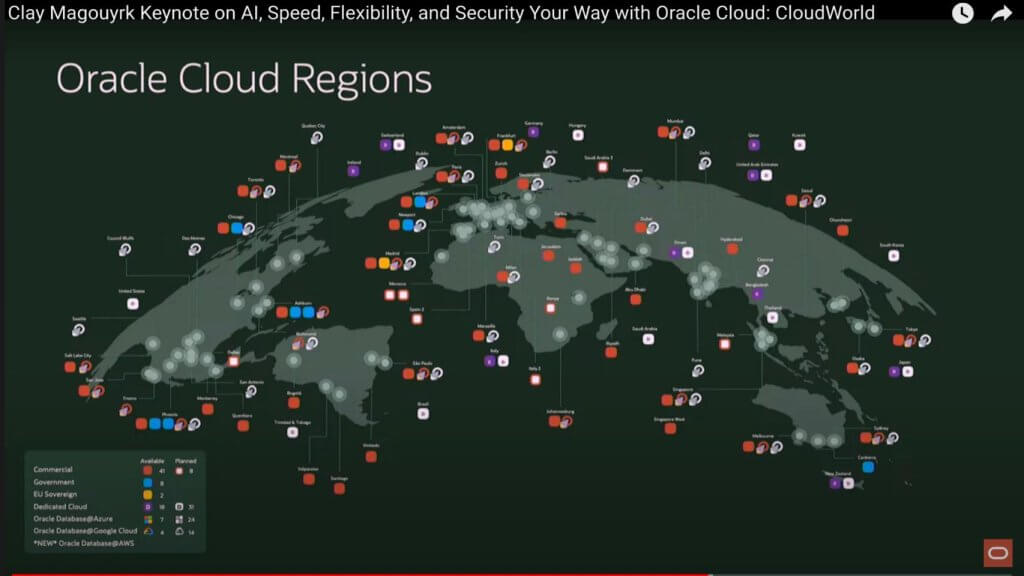
Let’s go with Larry’s numbers – we’ll let you count to fact-check the graphic above. With 85 live cloud regions and further expansion planned, Oracle is keen on outpacing its competitors in terms of regional availability. Larry Ellison’s mini-masterclass on data center construction in the last earnings call highlighted plans for a gigawatt data center and the use of nuclear energy, which underscores Oracle’s ambition and technical capability in scaling its infrastructure.
Key elements of OCI’s strategy include:
In our view, Oracle’s strategic investments and innovative approach position it uniquely in the cloud market, potentially offering the most integrated and scalable infrastructure solution available today. This approach not only caters to current enterprise needs but also sets a foundation for future cloud engagements across various industries.
Oracle continues to demonstrate leadership in the mission-critical database space, particularly with its advancements around the concept of “duality.” In our view, the ability to unify SQL, JSON and graph data within a single platform represents a pivotal development in how enterprises handle complex, multiformat datasets. As Juan Loaiza, executive vice president of mission-critical database technologies, highlighted in his keynote, Oracle’s focus on harmonizing distinct data types, such as SQL for structured data, JSON for document-oriented data, and graph for relationships, positions the company at the forefront of database innovation.
In his keynote presentation, shown below, Loaiza gave the example of a gaming application that required three distinct data types around athletes, events and attendees, all requiring different data with different formats that needs to be harmonized.
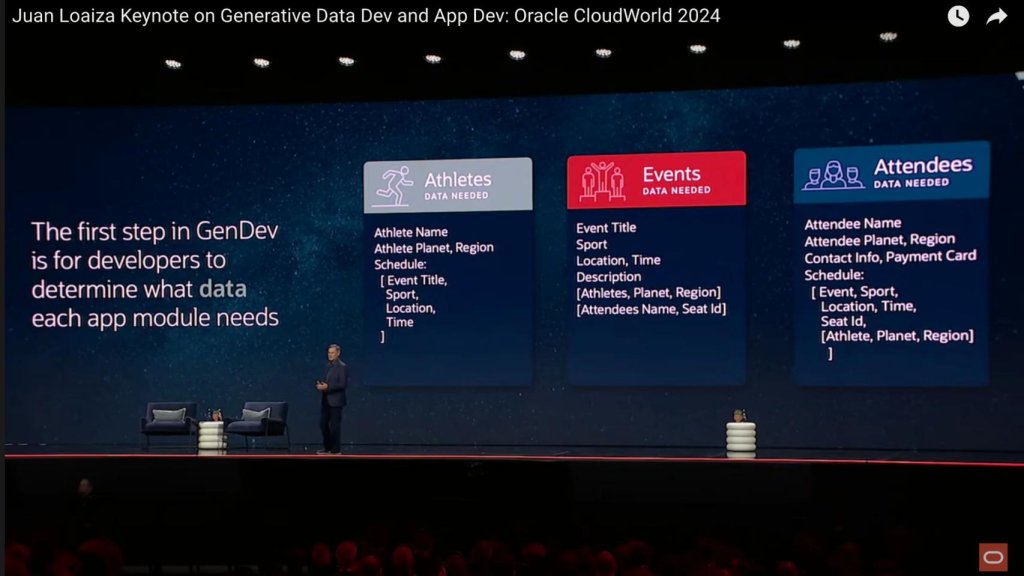
Oracle’s approach is designed to simplify the developer experience, offering what they call “duality views,” which allow organizations to change underlying data formats without disrupting the application logic. This functionality reduces the need for extensive data re-engineering, enabling faster, more efficient development of data-driven applications. In our assessment, this is a significant time-saver for organizations building complex applications, as it hides much of the complexity involved in managing diverse data types.
This innovation is perhaps even more significant than the AWS partnership announcement as it sets a technical foundation for the AI-native enterprise. More specifically, harmonized data enables swarms of intelligent agents to operate together creating a digital representation of an organization, in real time.
Key insights include:
Furthermore, Oracle’s MySQL HeatWave continues to innovate, pushing performance boundaries and delivering breakthroughs that extend its leadership in the database space. By bridging various data types and integrating them with Oracle’s autonomous database technologies, HeatWave acts as an evolving piece of the puzzle to enhance the overall performance and scalability of enterprise applications.
In our view, Oracle’s innovations in duality, Autonomous Database, 23ai and HeatWave represent important steps forward in enterprise database management. These advances not only address the growing complexity of data ecosystems but also position Oracle as a leader in delivering next-generation data solutions that align with the needs of modern developers and enterprises.
Oracle’s approach to data analytics and its emerging data lake strategy presents both strengths and areas where improvement is needed. In our view, the company’s focus on embedding analytics within its “Red Stack” — fully integrated with its databases, Fusion Apps and development environment (APEX) — provides a unified data and metadata model. This integration is a competitive differentiator, especially with the recent addition of Salesforce integration, reflecting Oracle’s ability to leverage both internal and third-party data sources seamlessly (notwithstanding that Salesforce runs on Oracle, making integration more facile).
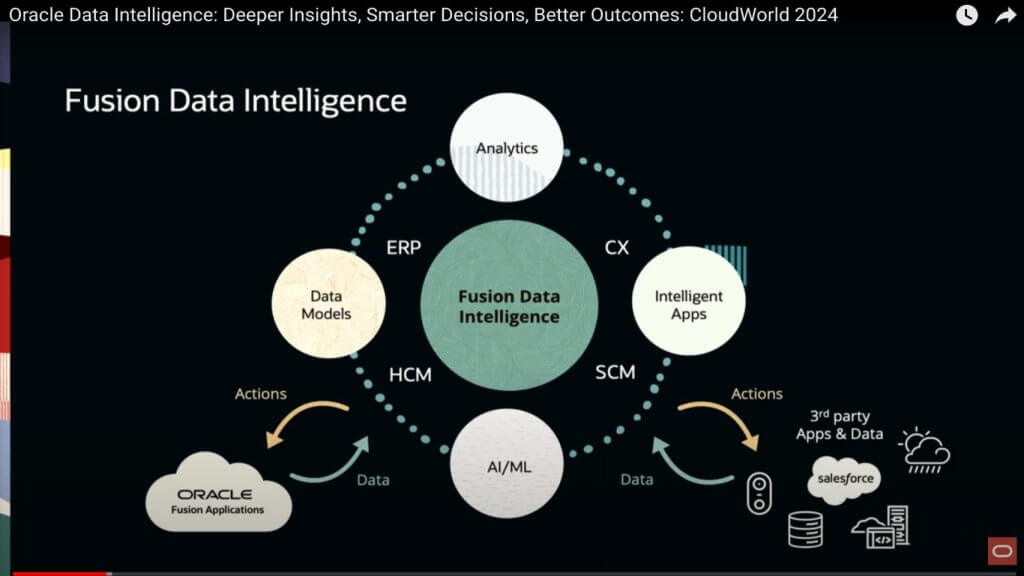
However, there are noticeable gaps in Oracle’s data lake strategy. While the company has announced support for open data formats such as Iceberg, Delta and Hudi, the data lake itself remains in preview mode, with a general availability release not expected until 2025. We believe this delay puts Oracle behind other players like Databricks Inc. and Snowflake Inc., which are more aggressive in their data lake offerings and adoption of open-source governance movements.
Key insights include:
In our view, Oracle’s unified data strategy has the potential to simplify complex data landscapes for enterprises. However, its delayed data lake strategy and uncertain market forces around governance present challenges that the company must address to compete with the more advanced offerings from Databricks and Snowflake.
Oracle’s emphasis on building multi-agent platforms represents a significant evolution in how enterprises will leverage AI to enhance productivity. As discussed in the keynote by Steve Miranda, Oracle’s executive vice president of Oracle applications development, the company is focused on deploying more than 50 distinct agents by next year, each designed to automate specific business tasks that have historically required human intervention. This marks a shift from the common industry focus on copilots and single-task agents to a broader, more integrated system of agents working in concert, driven by high-level business goals.
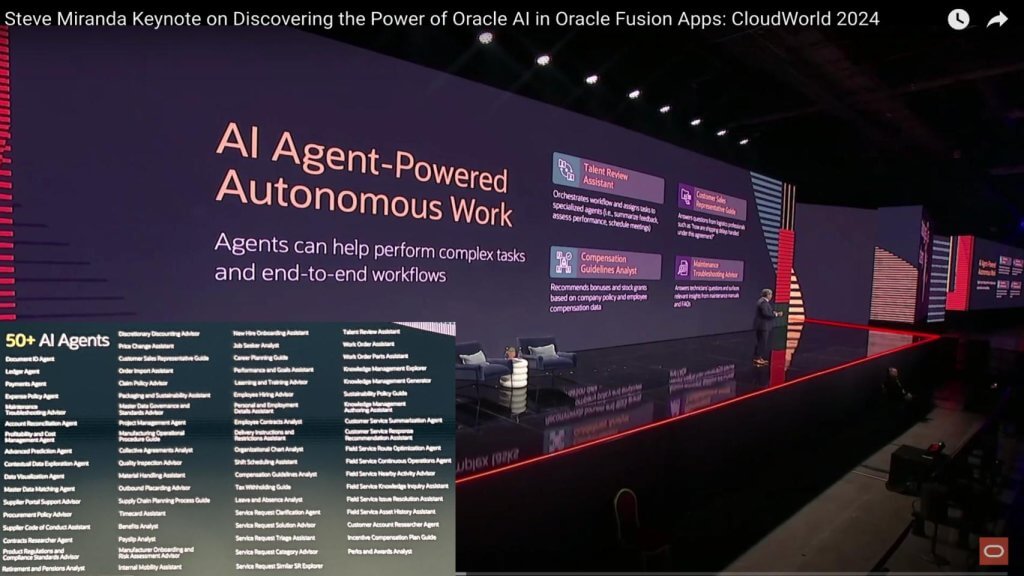
The value of this approach lies in its ability to create a fully connected and governed application ecosystem, where data from across Oracle’s portfolio — such as Fusion Apps, financial systems and customer relationship management solutions — can be harmonized to drive real-time, data-driven decision-making. By unifying data and operational analytics, Oracle enables enterprises to build a digital representation of their business, akin to an “Uber app for the enterprise,” where digital entities can respond dynamically to changing conditions.
Key insights include:
In our view, Oracle’s multi-agent strategy positions the company as a leader in enterprise automation. By leveraging its existing infrastructure and applications, Oracle provides a compelling proposition for organizations looking to streamline operations, reduce costs, and achieve 10 to 20-times improvements in productivity, as suggested by Ellison.
Net Score is a measure of spending momentum within a platform and represents a core component of the analysis conducted using data from ETR. The methodology is straightforward as shown below: It subtracts the percentage of customers reducing their spending (reds) from the percentage of customers either adding or increasing their spending (greens), offering a single metric that reflects the overall momentum of a technology vendor. This method uses the following categories:
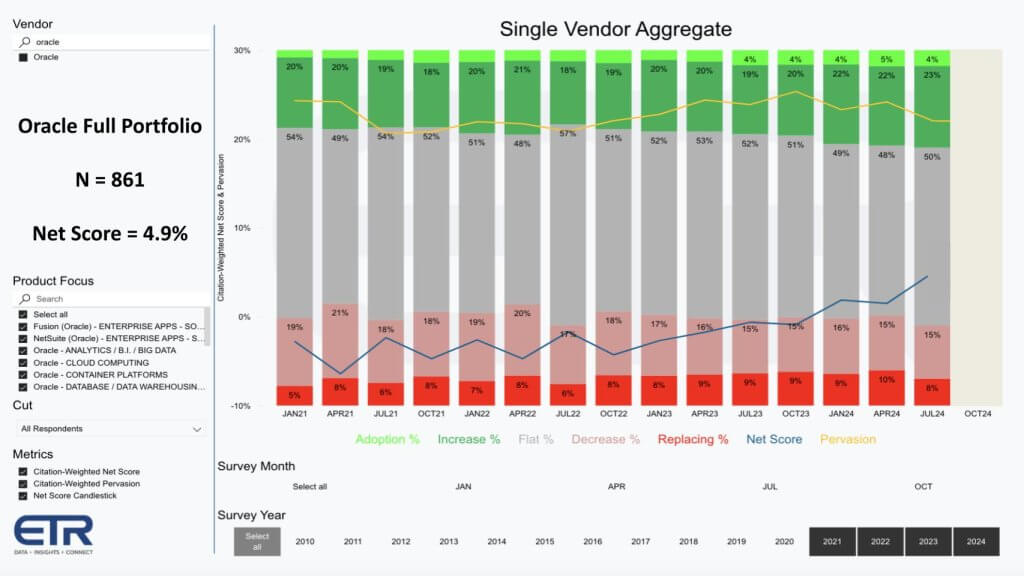
The Net Score is calculated by subtracting the “spending down” and “churn” percentages (reds) from the “adding new” and “spending more” percentages (greens). For Oracle, the total customer base in this survey is a large sample of 861, which represents a significant portion of the overall ETR survey pool of approximately 1,800 respondents.
In the broader survey across Oracle’s entire portfolio — including Fusion Apps, NetSuite Analytics, OCI and other services — Oracle achieved a Net Score of approximately 5%. While lower than some competitors, this score is typical for a legacy vendor, given the higher percentage of customers with flat spending (gray), which can penalize Net Score calculations. However, when isolating Oracle’s cloud services (OCI), the Net Score rises to nearly 15.6%, reflecting stronger momentum in the cloud space as shown in the following graphic.
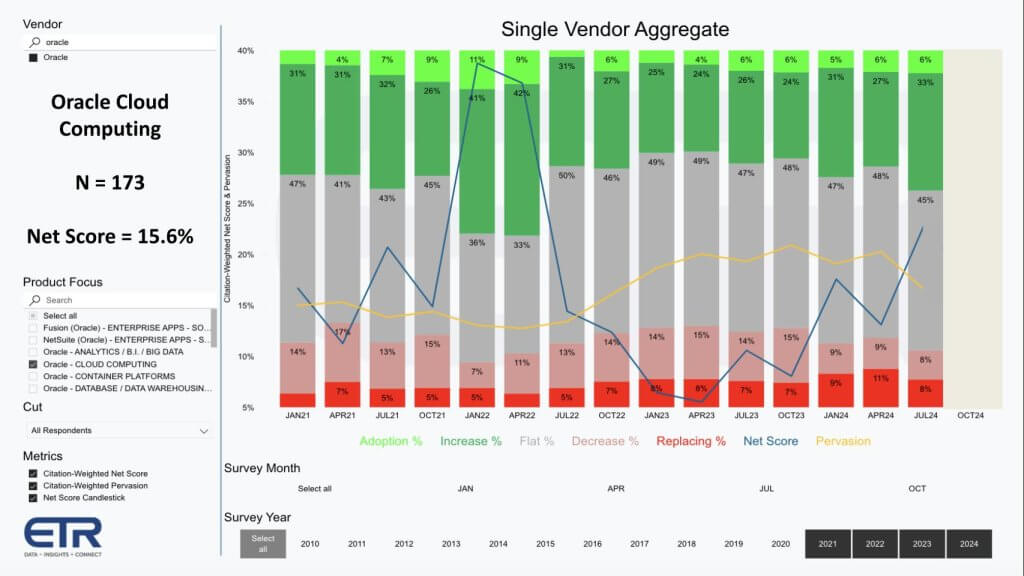
Key takeaways include:
In our view, the data suggests that Oracle has successfully positioned itself to maintain and grow its share of enterprise spending, particularly in the cloud computing sector. With a growing list of use cases, partners and regional cloud deployments, Oracle is providing compelling reasons for customers to revisit their Oracle investments. The company’s continued investment in OCI, coupled with its broader ecosystem of applications and cloud services, ensures that Oracle remains a critical player for enterprises with existing spending commitments.
We continue to research Oracle’s place in the enterprise IT ecosystem. Often maligned but always entertaining, founder-led Oracle is paving a new path toward the next era in the company’s long history.
Support our mission to keep content open and free by engaging with theCUBE community. Join theCUBE’s Alumni Trust Network, where technology leaders connect, share intelligence and create opportunities.
Founded by tech visionaries John Furrier and Dave Vellante, SiliconANGLE Media has built a dynamic ecosystem of industry-leading digital media brands that reach 15+ million elite tech professionals. Our new proprietary theCUBE AI Video Cloud is breaking ground in audience interaction, leveraging theCUBEai.com neural network to help technology companies make data-driven decisions and stay at the forefront of industry conversations.